Implementation of LMS: A Pilot Project at Ardhi University, Tanzania
VerifiedAdded on 2022/11/24
|16
|4621
|117
Project
AI Summary
This project proposal outlines the pilot implementation of a Learning Management System (LMS) at Ardhi University in Tanzania, with a focus on using Moodle. The project addresses the increasing demand for higher education by leveraging Information and Communication Technology (ICT) to improve access and quality of education. The document details the problem statement, project summary, SMART goals, LMS task requirements, user roles, technical requirements, evaluation criteria, and a project plan checklist. The project aims to enhance the learning experience, provide online resources, and facilitate assessments. The implementation includes a cloud-based system hosted in Australia and involves instructor-led training. The evaluation criteria include functionality, technology, costs, software suitability, and user experience. The project also covers crucial inquiries after implementation, a literature review, budget development, and a project timeline. The goal is to improve the efficiency and accessibility of education at Ardhi University and potentially expand to other institutions.
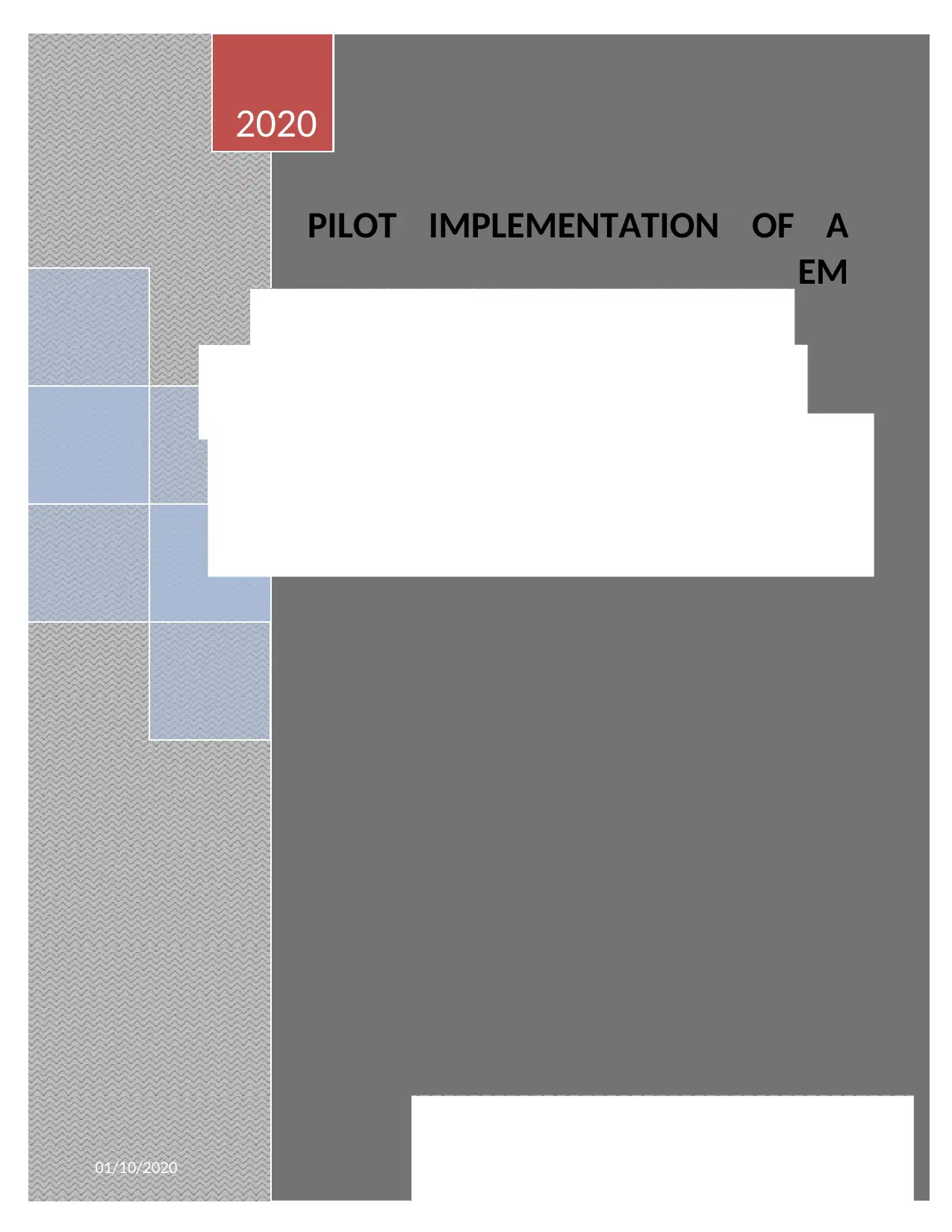
2020
PILOT IMPLEMENTATION OF A
EM
01/10/2020
PILOT IMPLEMENTATION OF A
EM
01/10/2020
Paraphrase This Document
Need a fresh take? Get an instant paraphrase of this document with our AI Paraphraser
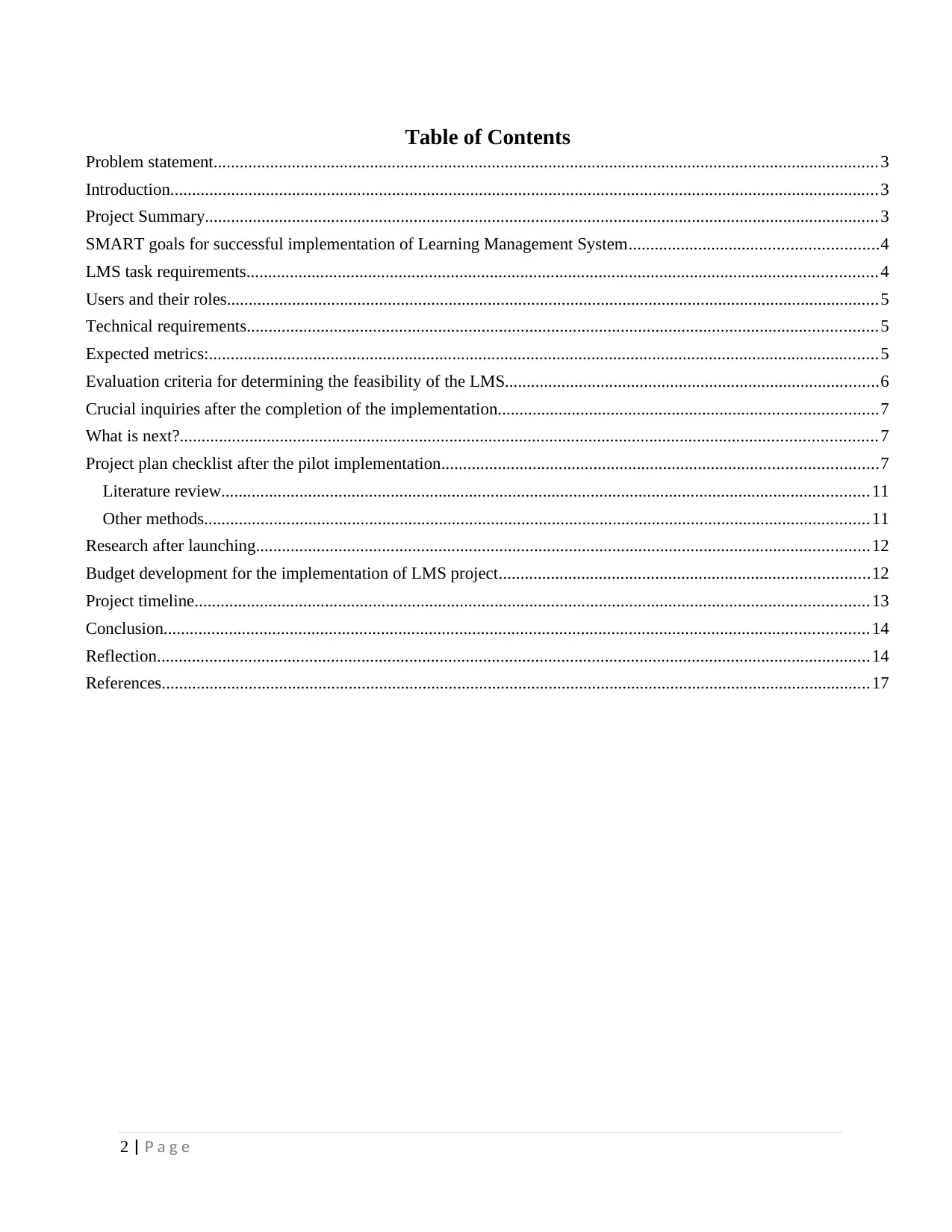
2 | P a g e
Table of Contents
Problem statement.........................................................................................................................................................3
Introduction................................................................................................................................................................... 3
Project Summary...........................................................................................................................................................3
SMART goals for successful implementation of Learning Management System.........................................................4
LMS task requirements.................................................................................................................................................4
Users and their roles......................................................................................................................................................5
Technical requirements.................................................................................................................................................5
Expected metrics:..........................................................................................................................................................5
Evaluation criteria for determining the feasibility of the LMS......................................................................................6
Crucial inquiries after the completion of the implementation.......................................................................................7
What is next?................................................................................................................................................................ 7
Project plan checklist after the pilot implementation....................................................................................................7
Literature review.....................................................................................................................................................11
Other methods.........................................................................................................................................................11
Research after launching.............................................................................................................................................12
Budget development for the implementation of LMS project.....................................................................................12
Project timeline...........................................................................................................................................................13
Conclusion.................................................................................................................................................................. 14
Reflection....................................................................................................................................................................14
References...................................................................................................................................................................17
Table of Contents
Problem statement.........................................................................................................................................................3
Introduction................................................................................................................................................................... 3
Project Summary...........................................................................................................................................................3
SMART goals for successful implementation of Learning Management System.........................................................4
LMS task requirements.................................................................................................................................................4
Users and their roles......................................................................................................................................................5
Technical requirements.................................................................................................................................................5
Expected metrics:..........................................................................................................................................................5
Evaluation criteria for determining the feasibility of the LMS......................................................................................6
Crucial inquiries after the completion of the implementation.......................................................................................7
What is next?................................................................................................................................................................ 7
Project plan checklist after the pilot implementation....................................................................................................7
Literature review.....................................................................................................................................................11
Other methods.........................................................................................................................................................11
Research after launching.............................................................................................................................................12
Budget development for the implementation of LMS project.....................................................................................12
Project timeline...........................................................................................................................................................13
Conclusion.................................................................................................................................................................. 14
Reflection....................................................................................................................................................................14
References...................................................................................................................................................................17
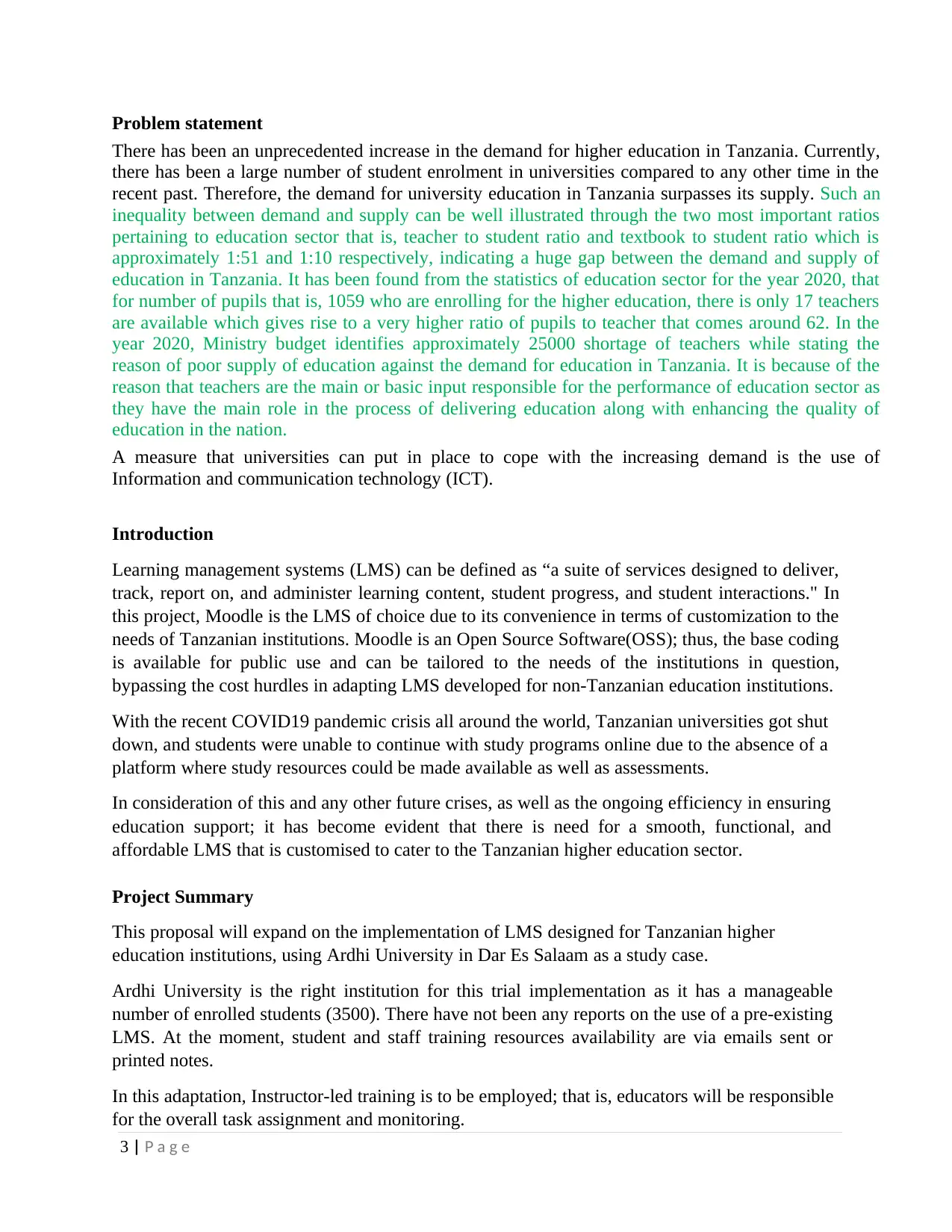
3 | P a g e
Problem statement
There has been an unprecedented increase in the demand for higher education in Tanzania. Currently,
there has been a large number of student enrolment in universities compared to any other time in the
recent past. Therefore, the demand for university education in Tanzania surpasses its supply. Such an
inequality between demand and supply can be well illustrated through the two most important ratios
pertaining to education sector that is, teacher to student ratio and textbook to student ratio which is
approximately 1:51 and 1:10 respectively, indicating a huge gap between the demand and supply of
education in Tanzania. It has been found from the statistics of education sector for the year 2020, that
for number of pupils that is, 1059 who are enrolling for the higher education, there is only 17 teachers
are available which gives rise to a very higher ratio of pupils to teacher that comes around 62. In the
year 2020, Ministry budget identifies approximately 25000 shortage of teachers while stating the
reason of poor supply of education against the demand for education in Tanzania. It is because of the
reason that teachers are the main or basic input responsible for the performance of education sector as
they have the main role in the process of delivering education along with enhancing the quality of
education in the nation.
A measure that universities can put in place to cope with the increasing demand is the use of
Information and communication technology (ICT).
Introduction
Learning management systems (LMS) can be defined as “a suite of services designed to deliver,
track, report on, and administer learning content, student progress, and student interactions." In
this project, Moodle is the LMS of choice due to its convenience in terms of customization to the
needs of Tanzanian institutions. Moodle is an Open Source Software(OSS); thus, the base coding
is available for public use and can be tailored to the needs of the institutions in question,
bypassing the cost hurdles in adapting LMS developed for non-Tanzanian education institutions.
With the recent COVID19 pandemic crisis all around the world, Tanzanian universities got shut
down, and students were unable to continue with study programs online due to the absence of a
platform where study resources could be made available as well as assessments.
In consideration of this and any other future crises, as well as the ongoing efficiency in ensuring
education support; it has become evident that there is need for a smooth, functional, and
affordable LMS that is customised to cater to the Tanzanian higher education sector.
Project Summary
This proposal will expand on the implementation of LMS designed for Tanzanian higher
education institutions, using Ardhi University in Dar Es Salaam as a study case.
Ardhi University is the right institution for this trial implementation as it has a manageable
number of enrolled students (3500). There have not been any reports on the use of a pre-existing
LMS. At the moment, student and staff training resources availability are via emails sent or
printed notes.
In this adaptation, Instructor-led training is to be employed; that is, educators will be responsible
for the overall task assignment and monitoring.
Problem statement
There has been an unprecedented increase in the demand for higher education in Tanzania. Currently,
there has been a large number of student enrolment in universities compared to any other time in the
recent past. Therefore, the demand for university education in Tanzania surpasses its supply. Such an
inequality between demand and supply can be well illustrated through the two most important ratios
pertaining to education sector that is, teacher to student ratio and textbook to student ratio which is
approximately 1:51 and 1:10 respectively, indicating a huge gap between the demand and supply of
education in Tanzania. It has been found from the statistics of education sector for the year 2020, that
for number of pupils that is, 1059 who are enrolling for the higher education, there is only 17 teachers
are available which gives rise to a very higher ratio of pupils to teacher that comes around 62. In the
year 2020, Ministry budget identifies approximately 25000 shortage of teachers while stating the
reason of poor supply of education against the demand for education in Tanzania. It is because of the
reason that teachers are the main or basic input responsible for the performance of education sector as
they have the main role in the process of delivering education along with enhancing the quality of
education in the nation.
A measure that universities can put in place to cope with the increasing demand is the use of
Information and communication technology (ICT).
Introduction
Learning management systems (LMS) can be defined as “a suite of services designed to deliver,
track, report on, and administer learning content, student progress, and student interactions." In
this project, Moodle is the LMS of choice due to its convenience in terms of customization to the
needs of Tanzanian institutions. Moodle is an Open Source Software(OSS); thus, the base coding
is available for public use and can be tailored to the needs of the institutions in question,
bypassing the cost hurdles in adapting LMS developed for non-Tanzanian education institutions.
With the recent COVID19 pandemic crisis all around the world, Tanzanian universities got shut
down, and students were unable to continue with study programs online due to the absence of a
platform where study resources could be made available as well as assessments.
In consideration of this and any other future crises, as well as the ongoing efficiency in ensuring
education support; it has become evident that there is need for a smooth, functional, and
affordable LMS that is customised to cater to the Tanzanian higher education sector.
Project Summary
This proposal will expand on the implementation of LMS designed for Tanzanian higher
education institutions, using Ardhi University in Dar Es Salaam as a study case.
Ardhi University is the right institution for this trial implementation as it has a manageable
number of enrolled students (3500). There have not been any reports on the use of a pre-existing
LMS. At the moment, student and staff training resources availability are via emails sent or
printed notes.
In this adaptation, Instructor-led training is to be employed; that is, educators will be responsible
for the overall task assignment and monitoring.
⊘ This is a preview!⊘
Do you want full access?
Subscribe today to unlock all pages.

Trusted by 1+ million students worldwide
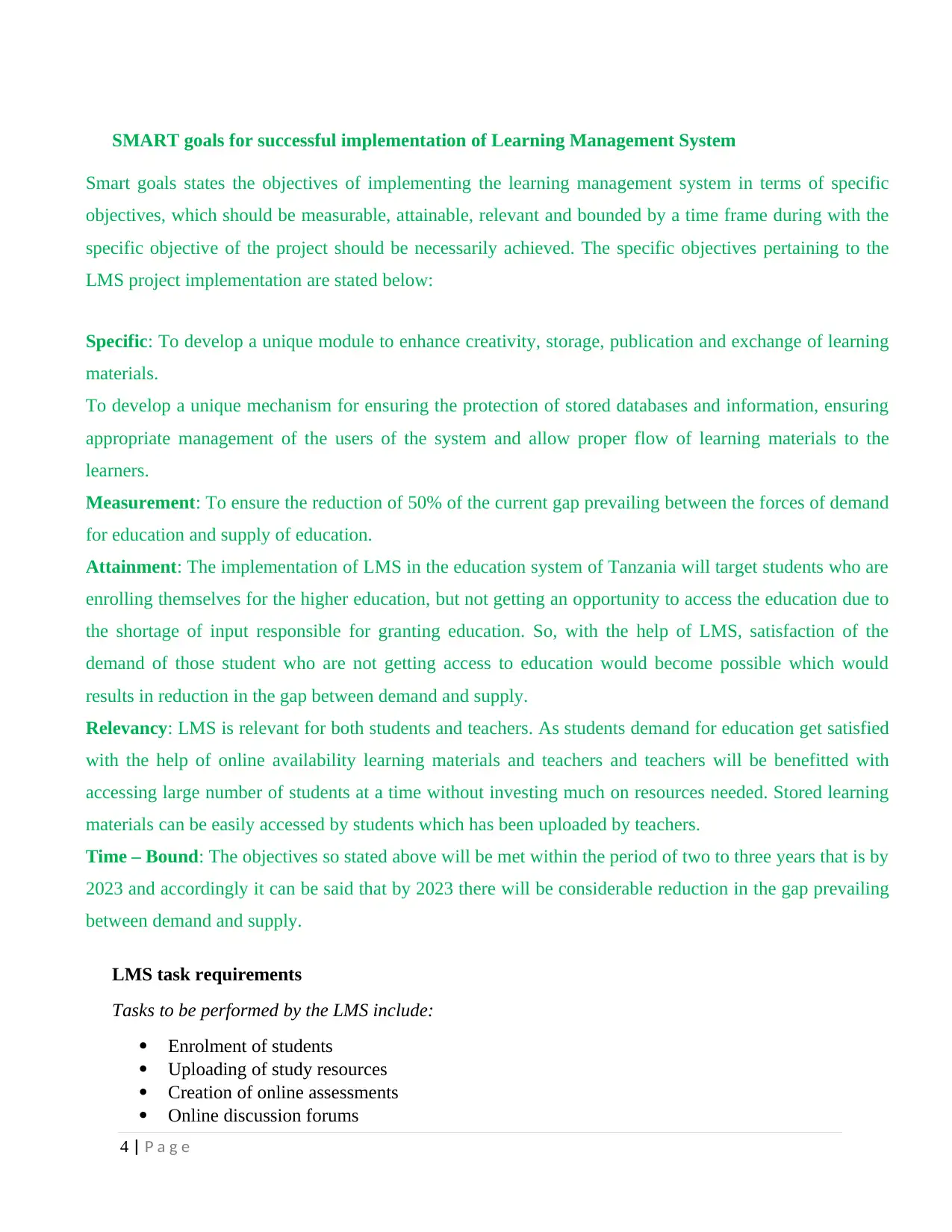
4 | P a g e
SMART goals for successful implementation of Learning Management System
Smart goals states the objectives of implementing the learning management system in terms of specific
objectives, which should be measurable, attainable, relevant and bounded by a time frame during with the
specific objective of the project should be necessarily achieved. The specific objectives pertaining to the
LMS project implementation are stated below:
Specific: To develop a unique module to enhance creativity, storage, publication and exchange of learning
materials.
To develop a unique mechanism for ensuring the protection of stored databases and information, ensuring
appropriate management of the users of the system and allow proper flow of learning materials to the
learners.
Measurement: To ensure the reduction of 50% of the current gap prevailing between the forces of demand
for education and supply of education.
Attainment: The implementation of LMS in the education system of Tanzania will target students who are
enrolling themselves for the higher education, but not getting an opportunity to access the education due to
the shortage of input responsible for granting education. So, with the help of LMS, satisfaction of the
demand of those student who are not getting access to education would become possible which would
results in reduction in the gap between demand and supply.
Relevancy: LMS is relevant for both students and teachers. As students demand for education get satisfied
with the help of online availability learning materials and teachers and teachers will be benefitted with
accessing large number of students at a time without investing much on resources needed. Stored learning
materials can be easily accessed by students which has been uploaded by teachers.
Time – Bound: The objectives so stated above will be met within the period of two to three years that is by
2023 and accordingly it can be said that by 2023 there will be considerable reduction in the gap prevailing
between demand and supply.
LMS task requirements
Tasks to be performed by the LMS include:
Enrolment of students
Uploading of study resources
Creation of online assessments
Online discussion forums
SMART goals for successful implementation of Learning Management System
Smart goals states the objectives of implementing the learning management system in terms of specific
objectives, which should be measurable, attainable, relevant and bounded by a time frame during with the
specific objective of the project should be necessarily achieved. The specific objectives pertaining to the
LMS project implementation are stated below:
Specific: To develop a unique module to enhance creativity, storage, publication and exchange of learning
materials.
To develop a unique mechanism for ensuring the protection of stored databases and information, ensuring
appropriate management of the users of the system and allow proper flow of learning materials to the
learners.
Measurement: To ensure the reduction of 50% of the current gap prevailing between the forces of demand
for education and supply of education.
Attainment: The implementation of LMS in the education system of Tanzania will target students who are
enrolling themselves for the higher education, but not getting an opportunity to access the education due to
the shortage of input responsible for granting education. So, with the help of LMS, satisfaction of the
demand of those student who are not getting access to education would become possible which would
results in reduction in the gap between demand and supply.
Relevancy: LMS is relevant for both students and teachers. As students demand for education get satisfied
with the help of online availability learning materials and teachers and teachers will be benefitted with
accessing large number of students at a time without investing much on resources needed. Stored learning
materials can be easily accessed by students which has been uploaded by teachers.
Time – Bound: The objectives so stated above will be met within the period of two to three years that is by
2023 and accordingly it can be said that by 2023 there will be considerable reduction in the gap prevailing
between demand and supply.
LMS task requirements
Tasks to be performed by the LMS include:
Enrolment of students
Uploading of study resources
Creation of online assessments
Online discussion forums
Paraphrase This Document
Need a fresh take? Get an instant paraphrase of this document with our AI Paraphraser
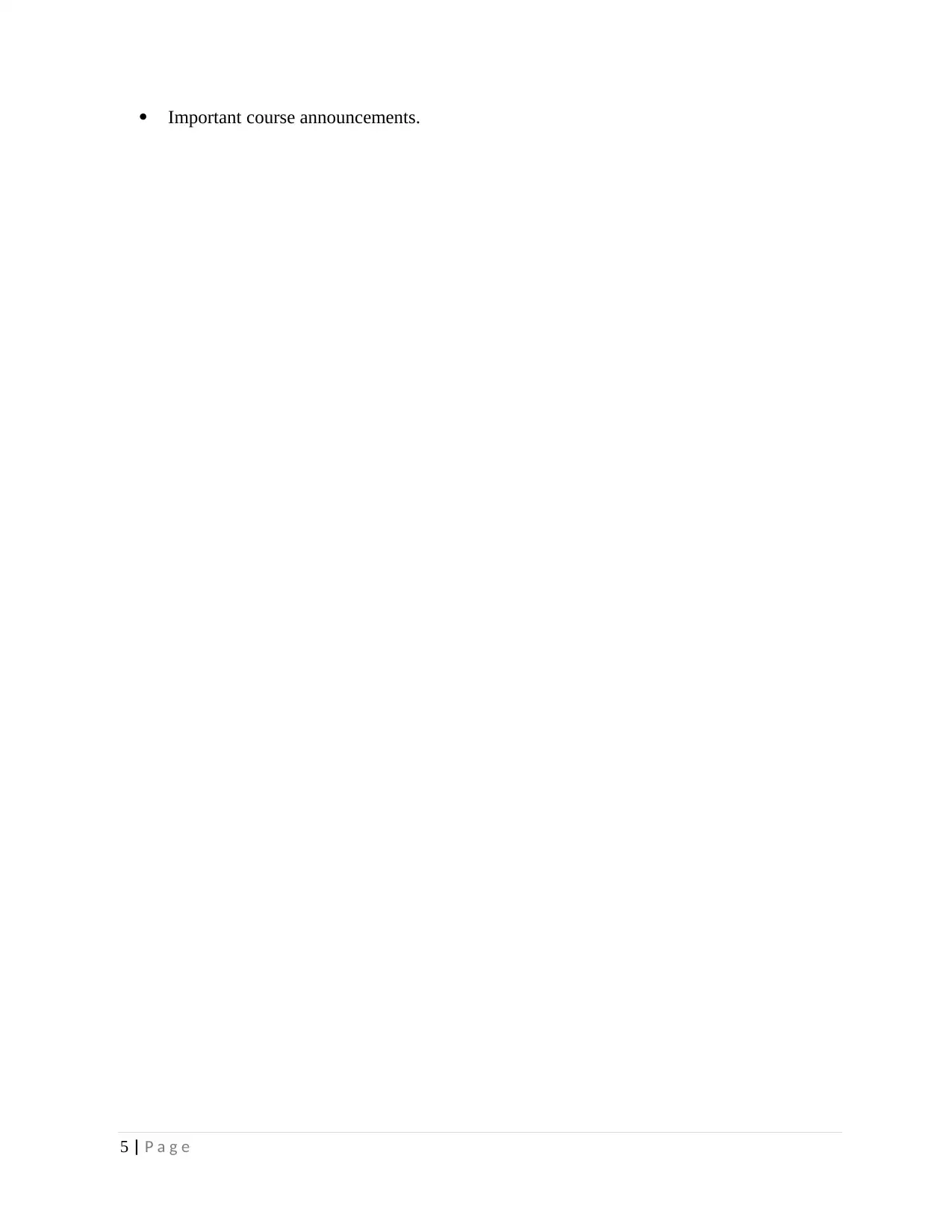
5 | P a g e
Important course announcements.
Important course announcements.
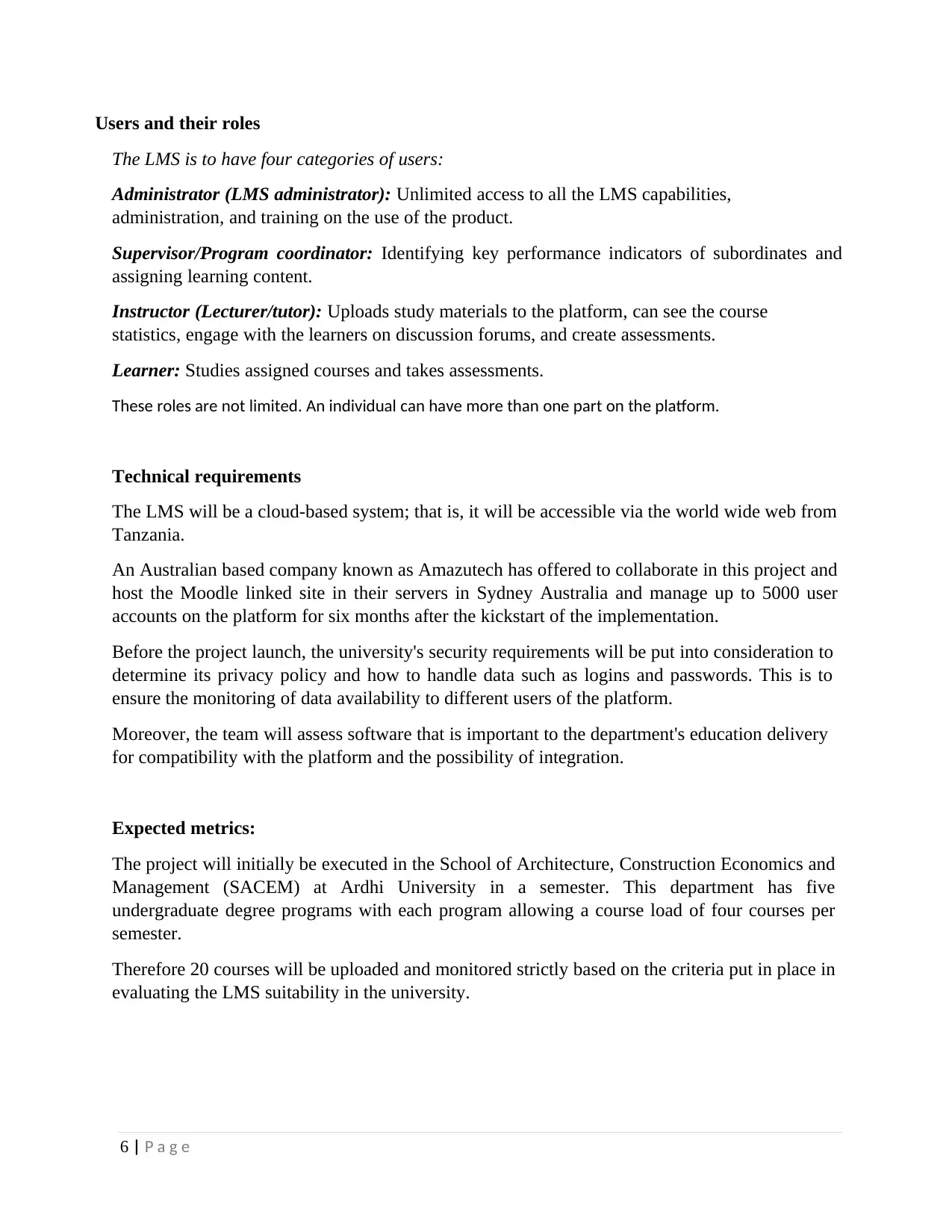
6 | P a g e
Users and their roles
The LMS is to have four categories of users:
Administrator (LMS administrator): Unlimited access to all the LMS capabilities,
administration, and training on the use of the product.
Supervisor/Program coordinator: Identifying key performance indicators of subordinates and
assigning learning content.
Instructor (Lecturer/tutor): Uploads study materials to the platform, can see the course
statistics, engage with the learners on discussion forums, and create assessments.
Learner: Studies assigned courses and takes assessments.
These roles are not limited. An individual can have more than one part on the platform.
Technical requirements
The LMS will be a cloud-based system; that is, it will be accessible via the world wide web from
Tanzania.
An Australian based company known as Amazutech has offered to collaborate in this project and
host the Moodle linked site in their servers in Sydney Australia and manage up to 5000 user
accounts on the platform for six months after the kickstart of the implementation.
Before the project launch, the university's security requirements will be put into consideration to
determine its privacy policy and how to handle data such as logins and passwords. This is to
ensure the monitoring of data availability to different users of the platform.
Moreover, the team will assess software that is important to the department's education delivery
for compatibility with the platform and the possibility of integration.
Expected metrics:
The project will initially be executed in the School of Architecture, Construction Economics and
Management (SACEM) at Ardhi University in a semester. This department has five
undergraduate degree programs with each program allowing a course load of four courses per
semester.
Therefore 20 courses will be uploaded and monitored strictly based on the criteria put in place in
evaluating the LMS suitability in the university.
Users and their roles
The LMS is to have four categories of users:
Administrator (LMS administrator): Unlimited access to all the LMS capabilities,
administration, and training on the use of the product.
Supervisor/Program coordinator: Identifying key performance indicators of subordinates and
assigning learning content.
Instructor (Lecturer/tutor): Uploads study materials to the platform, can see the course
statistics, engage with the learners on discussion forums, and create assessments.
Learner: Studies assigned courses and takes assessments.
These roles are not limited. An individual can have more than one part on the platform.
Technical requirements
The LMS will be a cloud-based system; that is, it will be accessible via the world wide web from
Tanzania.
An Australian based company known as Amazutech has offered to collaborate in this project and
host the Moodle linked site in their servers in Sydney Australia and manage up to 5000 user
accounts on the platform for six months after the kickstart of the implementation.
Before the project launch, the university's security requirements will be put into consideration to
determine its privacy policy and how to handle data such as logins and passwords. This is to
ensure the monitoring of data availability to different users of the platform.
Moreover, the team will assess software that is important to the department's education delivery
for compatibility with the platform and the possibility of integration.
Expected metrics:
The project will initially be executed in the School of Architecture, Construction Economics and
Management (SACEM) at Ardhi University in a semester. This department has five
undergraduate degree programs with each program allowing a course load of four courses per
semester.
Therefore 20 courses will be uploaded and monitored strictly based on the criteria put in place in
evaluating the LMS suitability in the university.
⊘ This is a preview!⊘
Do you want full access?
Subscribe today to unlock all pages.

Trusted by 1+ million students worldwide
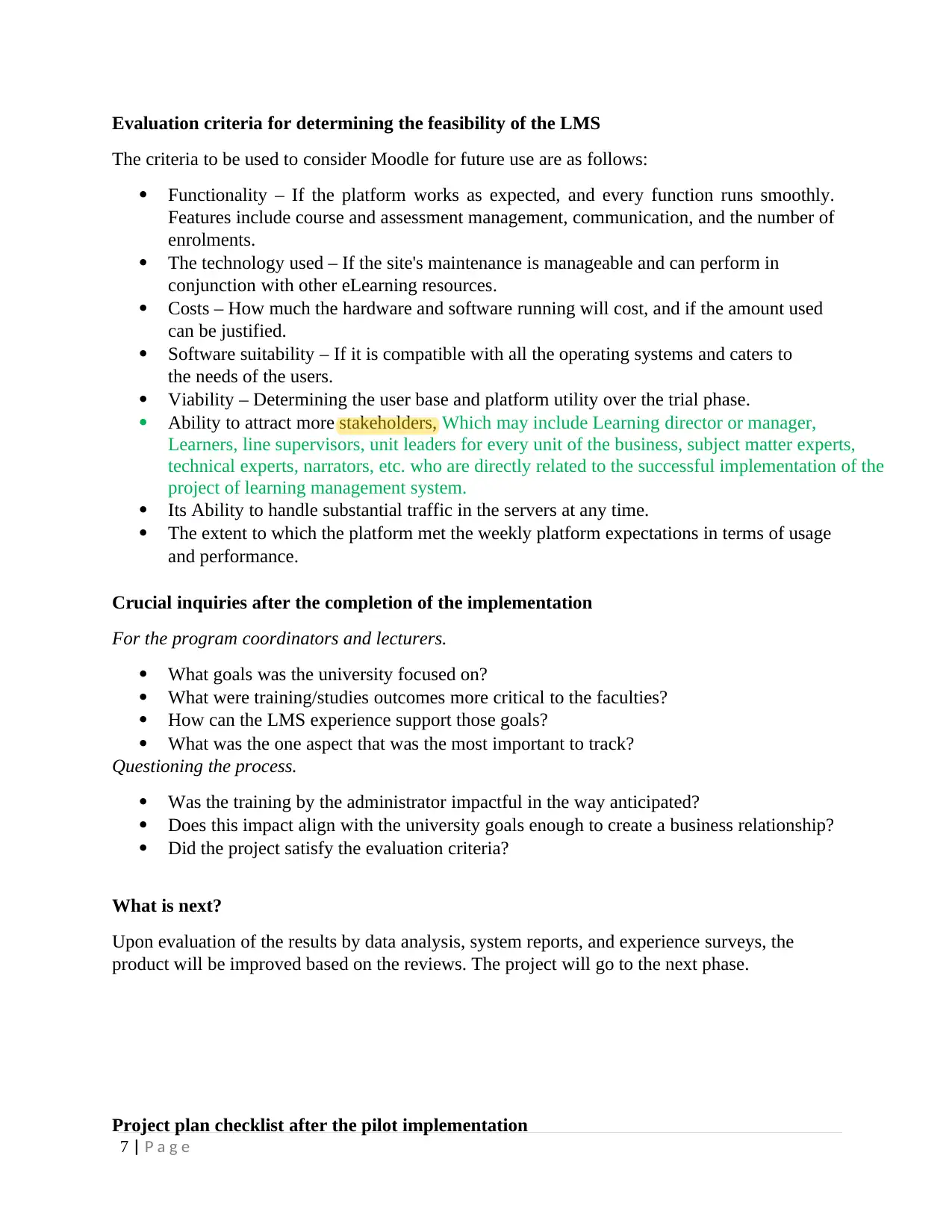
7 | P a g e
Evaluation criteria for determining the feasibility of the LMS
The criteria to be used to consider Moodle for future use are as follows:
Functionality – If the platform works as expected, and every function runs smoothly.
Features include course and assessment management, communication, and the number of
enrolments.
The technology used – If the site's maintenance is manageable and can perform in
conjunction with other eLearning resources.
Costs – How much the hardware and software running will cost, and if the amount used
can be justified.
Software suitability – If it is compatible with all the operating systems and caters to
the needs of the users.
Viability – Determining the user base and platform utility over the trial phase.
Ability to attract more stakeholders, Which may include Learning director or manager,
Learners, line supervisors, unit leaders for every unit of the business, subject matter experts,
technical experts, narrators, etc. who are directly related to the successful implementation of the
project of learning management system.
Its Ability to handle substantial traffic in the servers at any time.
The extent to which the platform met the weekly platform expectations in terms of usage
and performance.
Crucial inquiries after the completion of the implementation
For the program coordinators and lecturers.
What goals was the university focused on?
What were training/studies outcomes more critical to the faculties?
How can the LMS experience support those goals?
What was the one aspect that was the most important to track?
Questioning the process.
Was the training by the administrator impactful in the way anticipated?
Does this impact align with the university goals enough to create a business relationship?
Did the project satisfy the evaluation criteria?
What is next?
Upon evaluation of the results by data analysis, system reports, and experience surveys, the
product will be improved based on the reviews. The project will go to the next phase.
Project plan checklist after the pilot implementation
Evaluation criteria for determining the feasibility of the LMS
The criteria to be used to consider Moodle for future use are as follows:
Functionality – If the platform works as expected, and every function runs smoothly.
Features include course and assessment management, communication, and the number of
enrolments.
The technology used – If the site's maintenance is manageable and can perform in
conjunction with other eLearning resources.
Costs – How much the hardware and software running will cost, and if the amount used
can be justified.
Software suitability – If it is compatible with all the operating systems and caters to
the needs of the users.
Viability – Determining the user base and platform utility over the trial phase.
Ability to attract more stakeholders, Which may include Learning director or manager,
Learners, line supervisors, unit leaders for every unit of the business, subject matter experts,
technical experts, narrators, etc. who are directly related to the successful implementation of the
project of learning management system.
Its Ability to handle substantial traffic in the servers at any time.
The extent to which the platform met the weekly platform expectations in terms of usage
and performance.
Crucial inquiries after the completion of the implementation
For the program coordinators and lecturers.
What goals was the university focused on?
What were training/studies outcomes more critical to the faculties?
How can the LMS experience support those goals?
What was the one aspect that was the most important to track?
Questioning the process.
Was the training by the administrator impactful in the way anticipated?
Does this impact align with the university goals enough to create a business relationship?
Did the project satisfy the evaluation criteria?
What is next?
Upon evaluation of the results by data analysis, system reports, and experience surveys, the
product will be improved based on the reviews. The project will go to the next phase.
Project plan checklist after the pilot implementation
Paraphrase This Document
Need a fresh take? Get an instant paraphrase of this document with our AI Paraphraser
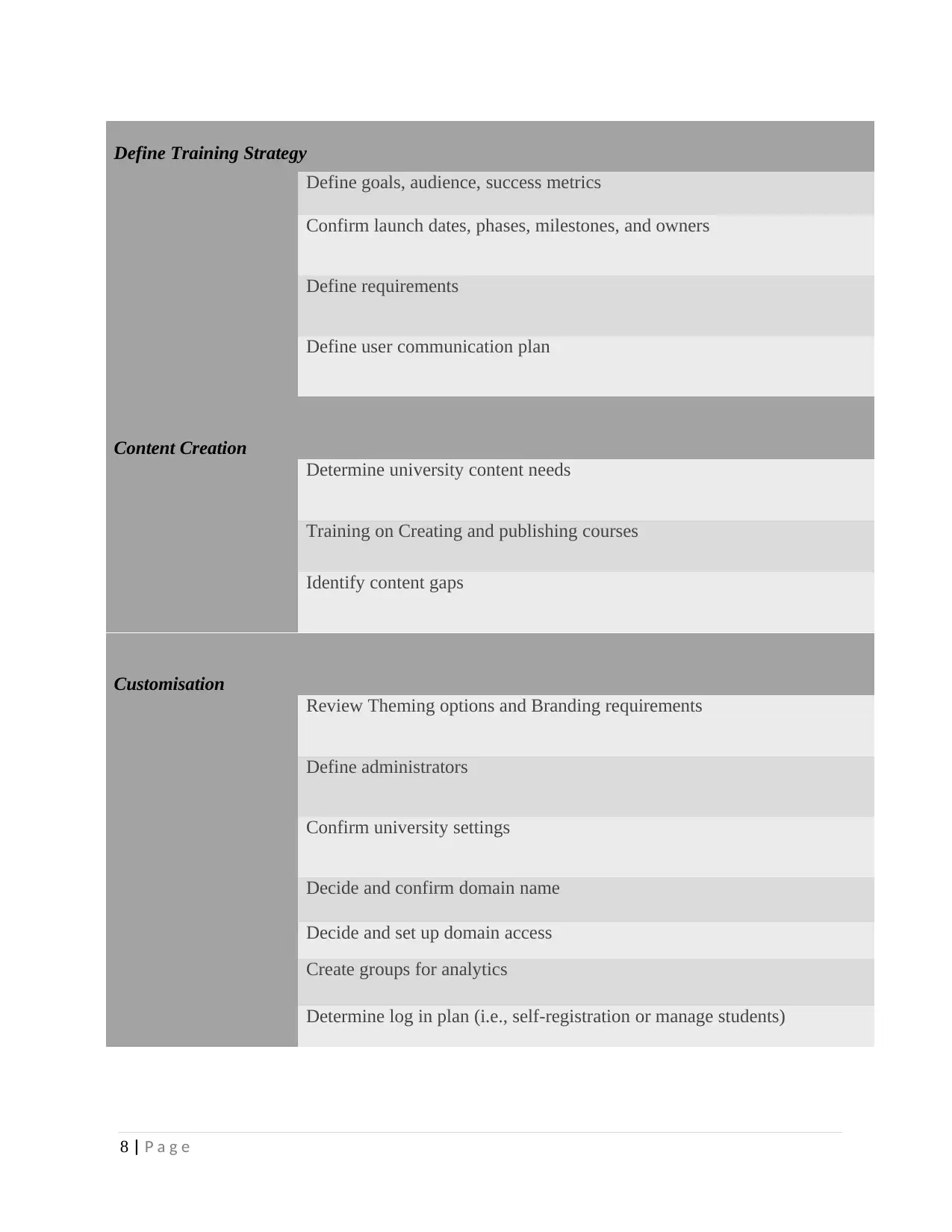
8 | P a g e
Define Training Strategy
Define goals, audience, success metrics
Confirm launch dates, phases, milestones, and owners
Define requirements
Define user communication plan
Content Creation
Determine university content needs
Training on Creating and publishing courses
Identify content gaps
Customisation
Review Theming options and Branding requirements
Define administrators
Confirm university settings
Decide and confirm domain name
Decide and set up domain access
Create groups for analytics
Determine log in plan (i.e., self-registration or manage students)
Define Training Strategy
Define goals, audience, success metrics
Confirm launch dates, phases, milestones, and owners
Define requirements
Define user communication plan
Content Creation
Determine university content needs
Training on Creating and publishing courses
Identify content gaps
Customisation
Review Theming options and Branding requirements
Define administrators
Confirm university settings
Decide and confirm domain name
Decide and set up domain access
Create groups for analytics
Determine log in plan (i.e., self-registration or manage students)
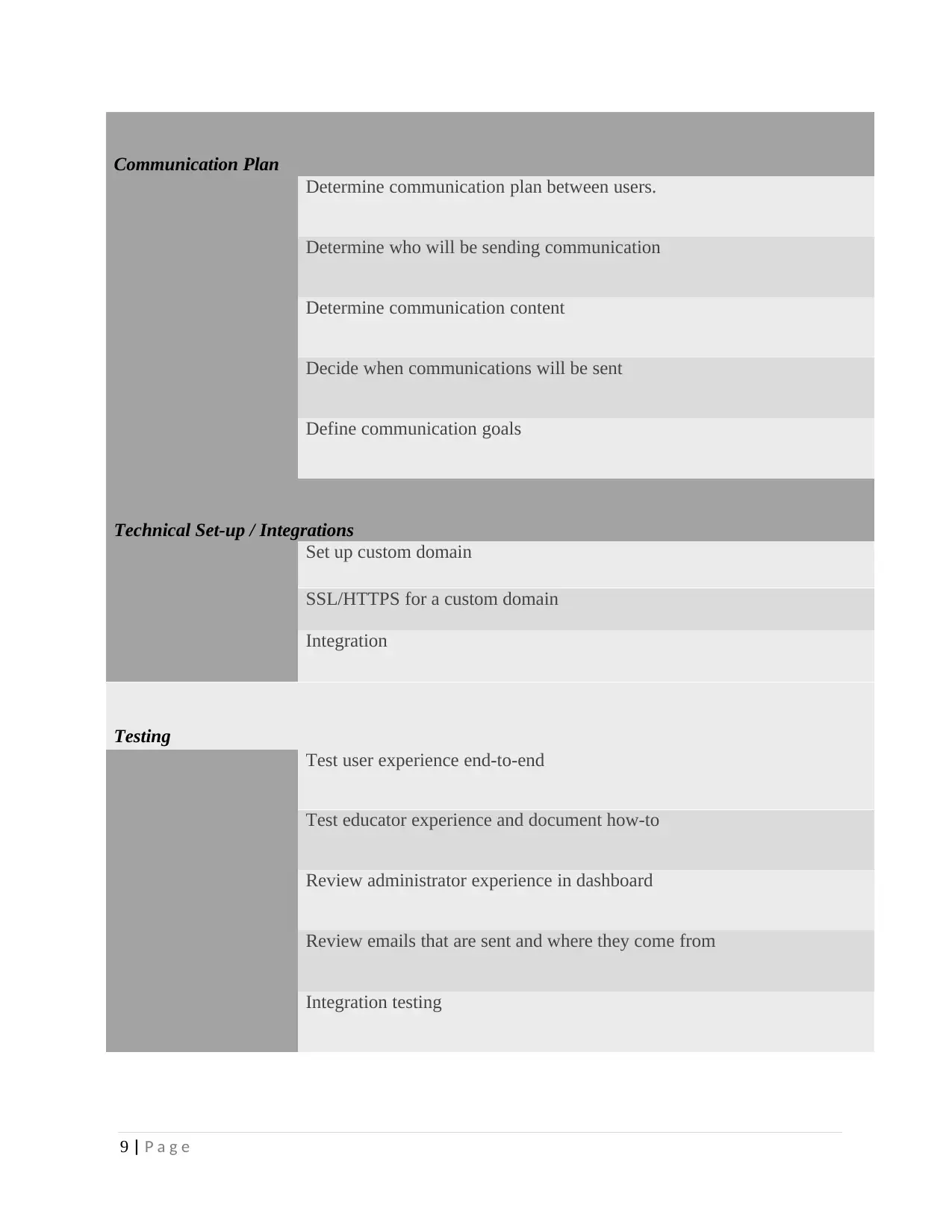
9 | P a g e
Communication Plan
Determine communication plan between users.
Determine who will be sending communication
Determine communication content
Decide when communications will be sent
Define communication goals
Technical Set-up / Integrations
Set up custom domain
SSL/HTTPS for a custom domain
Integration
Testing
Test user experience end-to-end
Test educator experience and document how-to
Review administrator experience in dashboard
Review emails that are sent and where they come from
Integration testing
Communication Plan
Determine communication plan between users.
Determine who will be sending communication
Determine communication content
Decide when communications will be sent
Define communication goals
Technical Set-up / Integrations
Set up custom domain
SSL/HTTPS for a custom domain
Integration
Testing
Test user experience end-to-end
Test educator experience and document how-to
Review administrator experience in dashboard
Review emails that are sent and where they come from
Integration testing
⊘ This is a preview!⊘
Do you want full access?
Subscribe today to unlock all pages.

Trusted by 1+ million students worldwide
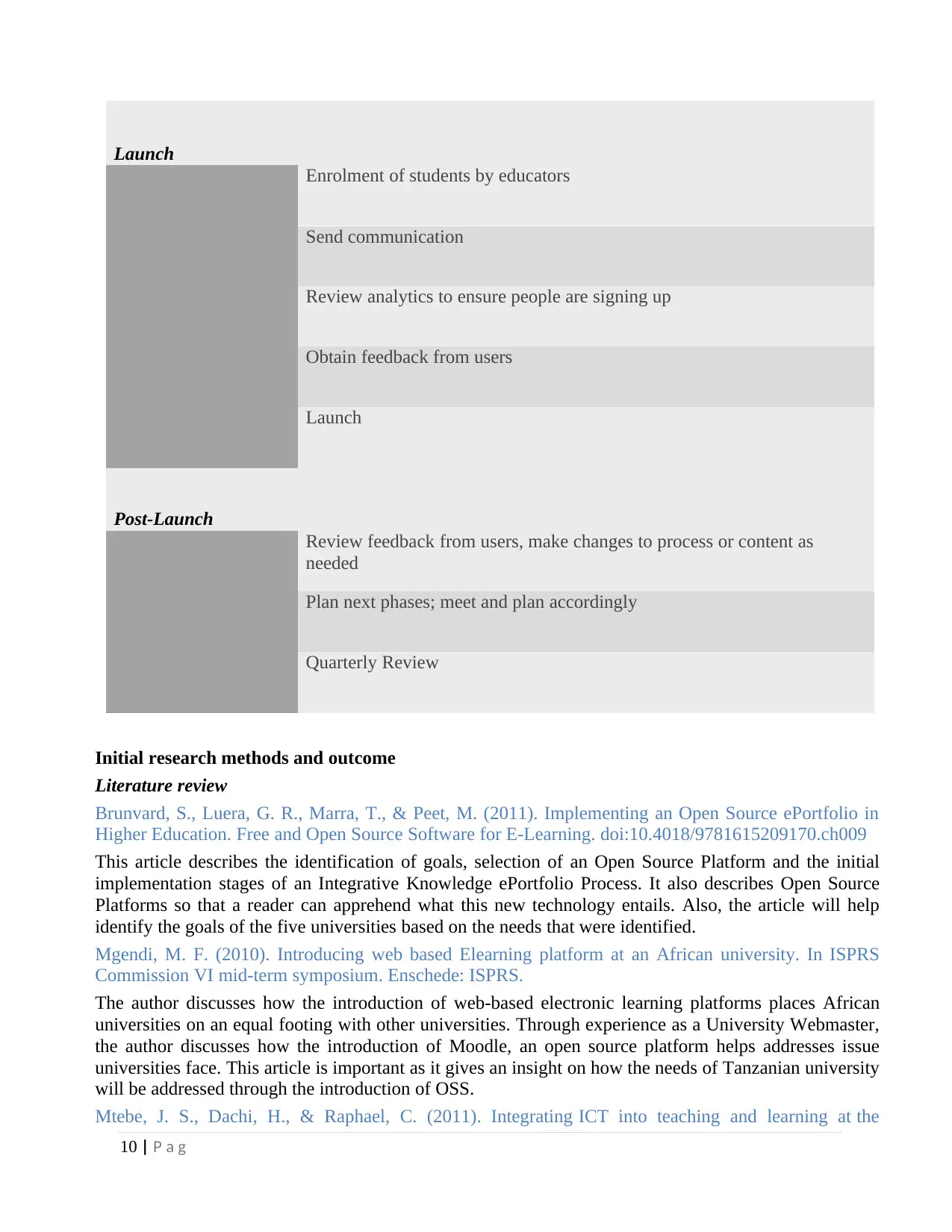
10 | P a g
Launch
Enrolment of students by educators
Send communication
Review analytics to ensure people are signing up
Obtain feedback from users
Launch
Post-Launch
Review feedback from users, make changes to process or content as
needed
Plan next phases; meet and plan accordingly
Quarterly Review
Initial research methods and outcome
Literature review
Brunvard, S., Luera, G. R., Marra, T., & Peet, M. (2011). Implementing an Open Source ePortfolio in
Higher Education. Free and Open Source Software for E-Learning. doi:10.4018/9781615209170.ch009
This article describes the identification of goals, selection of an Open Source Platform and the initial
implementation stages of an Integrative Knowledge ePortfolio Process. It also describes Open Source
Platforms so that a reader can apprehend what this new technology entails. Also, the article will help
identify the goals of the five universities based on the needs that were identified.
Mgendi, M. F. (2010). Introducing web based Elearning platform at an African university. In ISPRS
Commission VI mid-term symposium. Enschede: ISPRS.
The author discusses how the introduction of web-based electronic learning platforms places African
universities on an equal footing with other universities. Through experience as a University Webmaster,
the author discusses how the introduction of Moodle, an open source platform helps addresses issue
universities face. This article is important as it gives an insight on how the needs of Tanzanian university
will be addressed through the introduction of OSS.
Mtebe, J. S., Dachi, H., & Raphael, C. (2011). Integrating ICT into teaching and learning at the
Launch
Enrolment of students by educators
Send communication
Review analytics to ensure people are signing up
Obtain feedback from users
Launch
Post-Launch
Review feedback from users, make changes to process or content as
needed
Plan next phases; meet and plan accordingly
Quarterly Review
Initial research methods and outcome
Literature review
Brunvard, S., Luera, G. R., Marra, T., & Peet, M. (2011). Implementing an Open Source ePortfolio in
Higher Education. Free and Open Source Software for E-Learning. doi:10.4018/9781615209170.ch009
This article describes the identification of goals, selection of an Open Source Platform and the initial
implementation stages of an Integrative Knowledge ePortfolio Process. It also describes Open Source
Platforms so that a reader can apprehend what this new technology entails. Also, the article will help
identify the goals of the five universities based on the needs that were identified.
Mgendi, M. F. (2010). Introducing web based Elearning platform at an African university. In ISPRS
Commission VI mid-term symposium. Enschede: ISPRS.
The author discusses how the introduction of web-based electronic learning platforms places African
universities on an equal footing with other universities. Through experience as a University Webmaster,
the author discusses how the introduction of Moodle, an open source platform helps addresses issue
universities face. This article is important as it gives an insight on how the needs of Tanzanian university
will be addressed through the introduction of OSS.
Mtebe, J. S., Dachi, H., & Raphael, C. (2011). Integrating ICT into teaching and learning at the
Paraphrase This Document
Need a fresh take? Get an instant paraphrase of this document with our AI Paraphraser
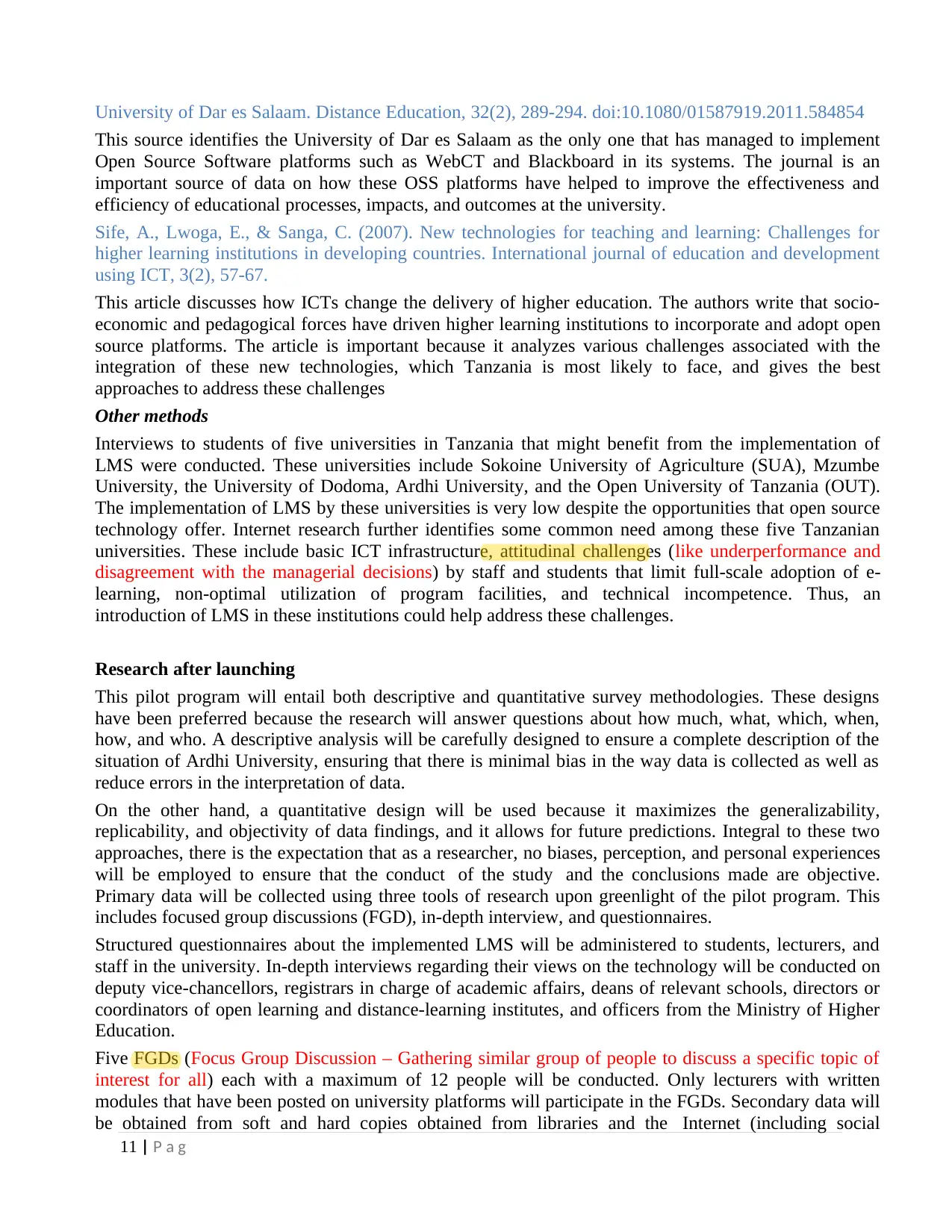
11 | P a g
University of Dar es Salaam. Distance Education, 32(2), 289-294. doi:10.1080/01587919.2011.584854
This source identifies the University of Dar es Salaam as the only one that has managed to implement
Open Source Software platforms such as WebCT and Blackboard in its systems. The journal is an
important source of data on how these OSS platforms have helped to improve the effectiveness and
efficiency of educational processes, impacts, and outcomes at the university.
Sife, A., Lwoga, E., & Sanga, C. (2007). New technologies for teaching and learning: Challenges for
higher learning institutions in developing countries. International journal of education and development
using ICT, 3(2), 57-67.
This article discusses how ICTs change the delivery of higher education. The authors write that socio-
economic and pedagogical forces have driven higher learning institutions to incorporate and adopt open
source platforms. The article is important because it analyzes various challenges associated with the
integration of these new technologies, which Tanzania is most likely to face, and gives the best
approaches to address these challenges
Other methods
Interviews to students of five universities in Tanzania that might benefit from the implementation of
LMS were conducted. These universities include Sokoine University of Agriculture (SUA), Mzumbe
University, the University of Dodoma, Ardhi University, and the Open University of Tanzania (OUT).
The implementation of LMS by these universities is very low despite the opportunities that open source
technology offer. Internet research further identifies some common need among these five Tanzanian
universities. These include basic ICT infrastructure, attitudinal challenges (like underperformance and
disagreement with the managerial decisions) by staff and students that limit full-scale adoption of e-
learning, non-optimal utilization of program facilities, and technical incompetence. Thus, an
introduction of LMS in these institutions could help address these challenges.
Research after launching
This pilot program will entail both descriptive and quantitative survey methodologies. These designs
have been preferred because the research will answer questions about how much, what, which, when,
how, and who. A descriptive analysis will be carefully designed to ensure a complete description of the
situation of Ardhi University, ensuring that there is minimal bias in the way data is collected as well as
reduce errors in the interpretation of data.
On the other hand, a quantitative design will be used because it maximizes the generalizability,
replicability, and objectivity of data findings, and it allows for future predictions. Integral to these two
approaches, there is the expectation that as a researcher, no biases, perception, and personal experiences
will be employed to ensure that the conduct of the study and the conclusions made are objective.
Primary data will be collected using three tools of research upon greenlight of the pilot program. This
includes focused group discussions (FGD), in-depth interview, and questionnaires.
Structured questionnaires about the implemented LMS will be administered to students, lecturers, and
staff in the university. In-depth interviews regarding their views on the technology will be conducted on
deputy vice-chancellors, registrars in charge of academic affairs, deans of relevant schools, directors or
coordinators of open learning and distance-learning institutes, and officers from the Ministry of Higher
Education.
Five FGDs (Focus Group Discussion – Gathering similar group of people to discuss a specific topic of
interest for all) each with a maximum of 12 people will be conducted. Only lecturers with written
modules that have been posted on university platforms will participate in the FGDs. Secondary data will
be obtained from soft and hard copies obtained from libraries and the Internet (including social
University of Dar es Salaam. Distance Education, 32(2), 289-294. doi:10.1080/01587919.2011.584854
This source identifies the University of Dar es Salaam as the only one that has managed to implement
Open Source Software platforms such as WebCT and Blackboard in its systems. The journal is an
important source of data on how these OSS platforms have helped to improve the effectiveness and
efficiency of educational processes, impacts, and outcomes at the university.
Sife, A., Lwoga, E., & Sanga, C. (2007). New technologies for teaching and learning: Challenges for
higher learning institutions in developing countries. International journal of education and development
using ICT, 3(2), 57-67.
This article discusses how ICTs change the delivery of higher education. The authors write that socio-
economic and pedagogical forces have driven higher learning institutions to incorporate and adopt open
source platforms. The article is important because it analyzes various challenges associated with the
integration of these new technologies, which Tanzania is most likely to face, and gives the best
approaches to address these challenges
Other methods
Interviews to students of five universities in Tanzania that might benefit from the implementation of
LMS were conducted. These universities include Sokoine University of Agriculture (SUA), Mzumbe
University, the University of Dodoma, Ardhi University, and the Open University of Tanzania (OUT).
The implementation of LMS by these universities is very low despite the opportunities that open source
technology offer. Internet research further identifies some common need among these five Tanzanian
universities. These include basic ICT infrastructure, attitudinal challenges (like underperformance and
disagreement with the managerial decisions) by staff and students that limit full-scale adoption of e-
learning, non-optimal utilization of program facilities, and technical incompetence. Thus, an
introduction of LMS in these institutions could help address these challenges.
Research after launching
This pilot program will entail both descriptive and quantitative survey methodologies. These designs
have been preferred because the research will answer questions about how much, what, which, when,
how, and who. A descriptive analysis will be carefully designed to ensure a complete description of the
situation of Ardhi University, ensuring that there is minimal bias in the way data is collected as well as
reduce errors in the interpretation of data.
On the other hand, a quantitative design will be used because it maximizes the generalizability,
replicability, and objectivity of data findings, and it allows for future predictions. Integral to these two
approaches, there is the expectation that as a researcher, no biases, perception, and personal experiences
will be employed to ensure that the conduct of the study and the conclusions made are objective.
Primary data will be collected using three tools of research upon greenlight of the pilot program. This
includes focused group discussions (FGD), in-depth interview, and questionnaires.
Structured questionnaires about the implemented LMS will be administered to students, lecturers, and
staff in the university. In-depth interviews regarding their views on the technology will be conducted on
deputy vice-chancellors, registrars in charge of academic affairs, deans of relevant schools, directors or
coordinators of open learning and distance-learning institutes, and officers from the Ministry of Higher
Education.
Five FGDs (Focus Group Discussion – Gathering similar group of people to discuss a specific topic of
interest for all) each with a maximum of 12 people will be conducted. Only lecturers with written
modules that have been posted on university platforms will participate in the FGDs. Secondary data will
be obtained from soft and hard copies obtained from libraries and the Internet (including social
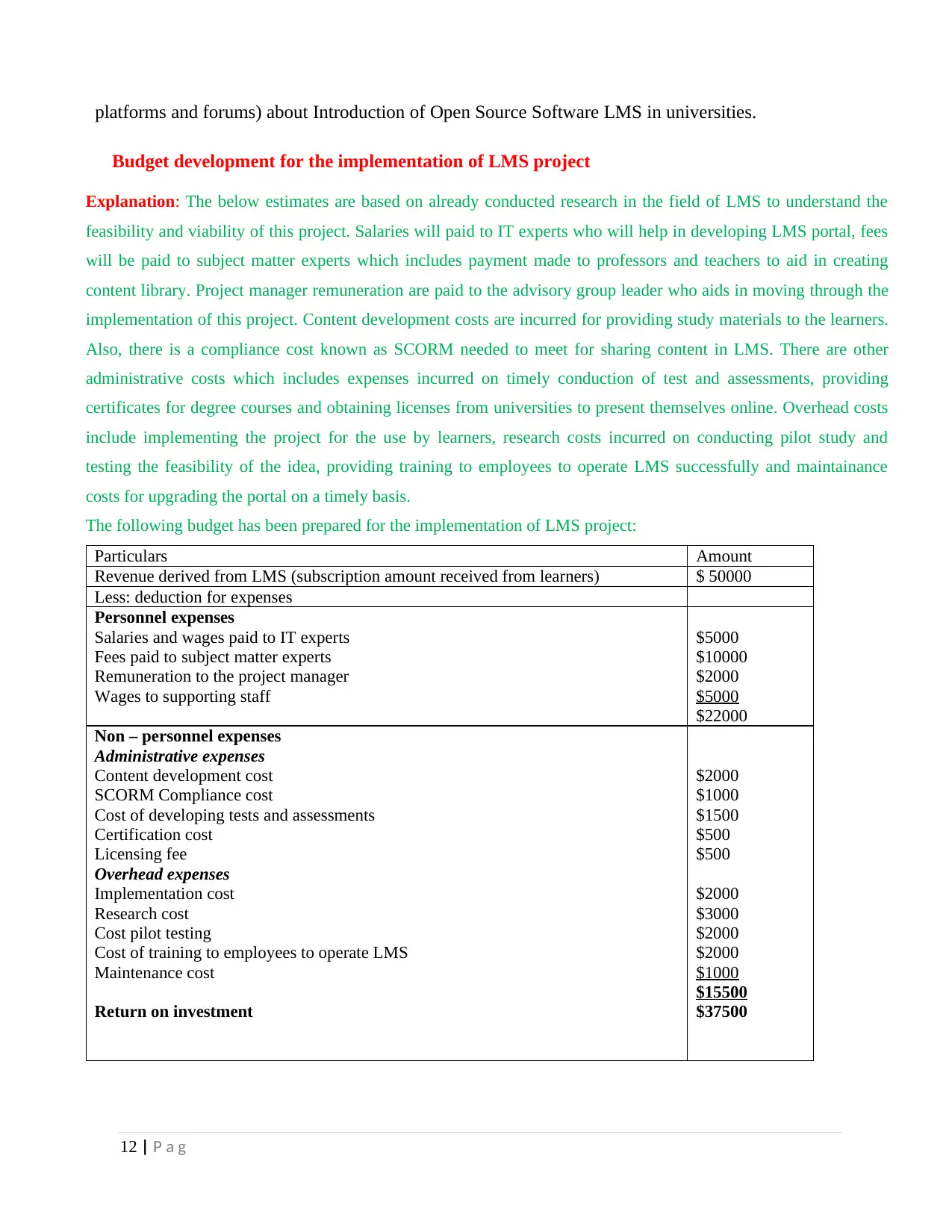
12 | P a g
platforms and forums) about Introduction of Open Source Software LMS in universities.
Budget development for the implementation of LMS project
Explanation: The below estimates are based on already conducted research in the field of LMS to understand the
feasibility and viability of this project. Salaries will paid to IT experts who will help in developing LMS portal, fees
will be paid to subject matter experts which includes payment made to professors and teachers to aid in creating
content library. Project manager remuneration are paid to the advisory group leader who aids in moving through the
implementation of this project. Content development costs are incurred for providing study materials to the learners.
Also, there is a compliance cost known as SCORM needed to meet for sharing content in LMS. There are other
administrative costs which includes expenses incurred on timely conduction of test and assessments, providing
certificates for degree courses and obtaining licenses from universities to present themselves online. Overhead costs
include implementing the project for the use by learners, research costs incurred on conducting pilot study and
testing the feasibility of the idea, providing training to employees to operate LMS successfully and maintainance
costs for upgrading the portal on a timely basis.
The following budget has been prepared for the implementation of LMS project:
Particulars Amount
Revenue derived from LMS (subscription amount received from learners) $ 50000
Less: deduction for expenses
Personnel expenses
Salaries and wages paid to IT experts
Fees paid to subject matter experts
Remuneration to the project manager
Wages to supporting staff
$5000
$10000
$2000
$5000
$22000
Non – personnel expenses
Administrative expenses
Content development cost
SCORM Compliance cost
Cost of developing tests and assessments
Certification cost
Licensing fee
Overhead expenses
Implementation cost
Research cost
Cost pilot testing
Cost of training to employees to operate LMS
Maintenance cost
Return on investment
$2000
$1000
$1500
$500
$500
$2000
$3000
$2000
$2000
$1000
$15500
$37500
platforms and forums) about Introduction of Open Source Software LMS in universities.
Budget development for the implementation of LMS project
Explanation: The below estimates are based on already conducted research in the field of LMS to understand the
feasibility and viability of this project. Salaries will paid to IT experts who will help in developing LMS portal, fees
will be paid to subject matter experts which includes payment made to professors and teachers to aid in creating
content library. Project manager remuneration are paid to the advisory group leader who aids in moving through the
implementation of this project. Content development costs are incurred for providing study materials to the learners.
Also, there is a compliance cost known as SCORM needed to meet for sharing content in LMS. There are other
administrative costs which includes expenses incurred on timely conduction of test and assessments, providing
certificates for degree courses and obtaining licenses from universities to present themselves online. Overhead costs
include implementing the project for the use by learners, research costs incurred on conducting pilot study and
testing the feasibility of the idea, providing training to employees to operate LMS successfully and maintainance
costs for upgrading the portal on a timely basis.
The following budget has been prepared for the implementation of LMS project:
Particulars Amount
Revenue derived from LMS (subscription amount received from learners) $ 50000
Less: deduction for expenses
Personnel expenses
Salaries and wages paid to IT experts
Fees paid to subject matter experts
Remuneration to the project manager
Wages to supporting staff
$5000
$10000
$2000
$5000
$22000
Non – personnel expenses
Administrative expenses
Content development cost
SCORM Compliance cost
Cost of developing tests and assessments
Certification cost
Licensing fee
Overhead expenses
Implementation cost
Research cost
Cost pilot testing
Cost of training to employees to operate LMS
Maintenance cost
Return on investment
$2000
$1000
$1500
$500
$500
$2000
$3000
$2000
$2000
$1000
$15500
$37500
⊘ This is a preview!⊘
Do you want full access?
Subscribe today to unlock all pages.

Trusted by 1+ million students worldwide
1 out of 16
Your All-in-One AI-Powered Toolkit for Academic Success.
+13062052269
info@desklib.com
Available 24*7 on WhatsApp / Email
![[object Object]](/_next/static/media/star-bottom.7253800d.svg)
Unlock your academic potential
Copyright © 2020–2025 A2Z Services. All Rights Reserved. Developed and managed by ZUCOL.


